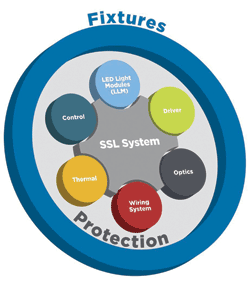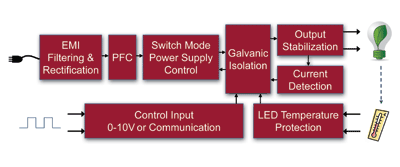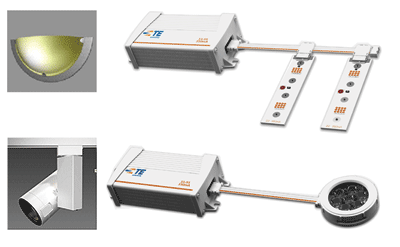To achieve optimum solutions, designers and manufacturers of SSL fixtures must rely on expertise in myriad technologies
BY ROB RIX
Vice President, Lighting
TE Connectivity
www.te.com
Complete solid-state lighting (SSL) solutions require technical expertise in myriad technologies — several distinct, high-level areas are easily identified (see Fig. 1 ). Knowledge in one area can be unique and the successful application of that know-how must be brought together at the systems level. Only in this way can an optimum lighting solution — one that takes into account the interaction between the technologies — be achieved.

Fig. 1: It take the multiple elements above to design a complete SSL system solution.
Color counts
Most EEs are already familiar with such key LED performance metrics as luminous efficacy (generally given in lm/W), total power consumption, and maximum current capability and its associated luminous output. But for SSL success, designers must also understand Correlated Color Temperature (CCT), Color Rendering Index (CRI) or Color Quality Scale (CQS).
Established by the Commission Internationale de l’Eclairage (CIE), a color-rendering index (CRI) rates how well a light source’s illumination of sample patches compares to the illumination from a reference source. The reference source is typically an incandescent lamp which approximates the ideal black body source and yields a CRI of 100 against which other light sources are measured. This is a somewhat subjective analysis that attempts to accommodate the tri-chromic nature of human vision.
With the advent of LED sources, the need has arisen for a color reference measurement technique to correct chromatic saturation deficiencies in the CRI method. A Color Quality Scale (CQS) is being developed at the National Institute of Standards & Technology (NIST) to address the problems of the CRI for solid-state light sources and to better communicate color quality to consumers. As opposed to the single number CRI, the CQS results in a composite number that more accurately defines a lamp’s ability to render colors in a manner pleasing to most consumers.
Another important LED parameter is its correlated color temperature (CCT), specified in Kelvin. The CCT provides a relative color appearance of a white light source when compared to a theoretical black body source. As a comparison, natural daylight often referenced as 5,000K (referred to as cool white), incandescent bulbs are approximately 2,700 to 3,000K (referred to as warm white), and fluorescent bulbs are typically 2,700 to 5,500K. White LEDs are also identified as warm, neutral, and cool based on CCT ratings.
Even though solid-state lighting is produced in very sophisticated processing facilities, there are many variations between the LEDs produced, even during the same run. Variations in forward voltage occur throughout the production simply due to normal statistical distributions inherent in all products. To provide repeatable and dependable systems, the LEDs must be electrically sorted based on this forward voltage.
A similar sorting is done to accommodate variations in the color of the blue LED chips and phosphor chemistry and density. This sorting results in the “bins” in which all LEDs are offered. The quality producer of LED systems will take all of these differences into account as the LEDs are matched for consistent color and performance.
Secondary optics’ challenges
LEDs are mounted on a flat surface and emit light from the top and sides in a hemispherical pattern (see Fig. 2 ). In addition to the primary optics that protect the LED chip in its device-level package, secondary optics provide greater functionality at the system level. The selection of the correct optic is based on efficiency, color shift, application requirements and cost.

Fig. 2: The above patterns of light from typical LEDs must be shaped by secondary optics to meet the demands of applications from narrow task lighting to broad general illumination.
Secondary optics optimize the distribution of the LED light for specific applications, such as down lighting, flood (broadly disbursed) lighting, or focused (spot) lighting. To accommodate these different distribution profiles, some system manufacturers offer interchangeable optics to achieve different distributions with the same package. With properly designed optics, light efficiencies can exceed 90% within the target illumination area.
Driving LEDs
The primary function of the driver module is supplying a controlled power level over the operating temperature range for the LED or LEDs in order to maintain a consistent light output. Power for the driver comes from the AC supply and the driver converts this AC input into a controlled DC current or voltage for most applications. Since the driver’s power requirements detract from the overall efficiency of the SSL system, very low power consumption drivers must be used for the most efficient lighting. (Note: luminous efficacy published by LED manufacturers typically refers only to the LED and does not include driver or optical losses.)
Functions provided by a typical LED driver module (see Fig.3 ) include protection features such as temperature protection, current detection and power factor correction (PFC), as well as several system level functions. Input control/communications provides the ability to interface not only with ac line or 0-10 Vdc dimmers, but also facility management systems and other emerging electronic controls such as daylight harvesting, occupancy detection, ambient light sensing and more.

Fig. 3: As seen in this functional block diagram for a typical SSL driver, the functions provided go beyond simply prooviding the appropriate current.
Interconnects in SSL systems
Interconnects (cables and connectors) have been a critical but unaddressed challenge for SSL systems. As system designers have found in electronic systems of all types, wiring and connections are unique in a consumer electronics product compared to an industrial product or a personal computer.
Wiring and connectors have a significant impact on the cost, manufacturability, operation, and overall reliability of SSL systems. Early versions of SSL use solder connections, but they cause several problems including limiting the flexibility of the design for future upgradability. Interconnects have system design implications and complexity well beyond the traditional lamp holder and lighting socket.
A standardized approach to connectors and wiring not only provides a cost-effective solution, it can prevent assembly problems of inadequately mated connectors, and readily identify/avoid mistakes through color coding and keyed design features (see Fig. 4 ). With a system-level approach to SSL interconnects, more than two wires are required, since more than power must be connected throughout the fixture.

Fig. 4: The standardized approach to SSL component interconnection of the NEVALO system uses keyed connectors and color-coded cables.
The new Energy Star standards differentiate between fixtures where the source and the systems are the separable or integral. There are different levels of performance associated with each. Integral designs cannot be upgraded or replaced. As a result, integral designs have to perform 20 to 30% better than other systems. Avoiding solder interfaces in the connectors is one means of achieving interchangeability, increased reliability and future upgradability.
Interconnects certainly represent an opportunity for improving solid-state lighting and, if properly designed, can result in:
• Rapid growth / adoption of SSL. Rapid platform / fixture / luminaire innovation. The economies of modularity.
Protection, thermal issues
Fault protection is a requirement for successful implementation and problem avoidance for any electronic circuitry and solid-state lighting is no exception. Since an SSL fixture is an electronic and not an electrical assembly, the protection requirements are much more sophisticated.
Typically, an LED driver module includes some level of protective circuitry to handle common faults that can occur in electronic systems, such as over-temperature, over-voltage, shorts, and, for dc circuits, reverse polarity.
Most LEDs are polarity-sensitive devices that require a dc voltage source. However, even ac LEDs need much greater protection than ordinary electrical devices. In addition to standard electronic circuit protection, SSL can be exposed to extreme surge conditions, such as power-line lightning strikes. Any power-line-coupled transients can reduce LED lifetimes, and, in the worst case, result in immediate failure.
Adequate thermal protection for temperature-sensitive LEDs requires localized temperature measurements. The measurements are needed to support a sufficiently quick response, including shut down if necessary, to limit excessive temperature and thereby avoid stressing LEDs or contributing to early-life failure.
In systems with several LED subassemblies, each subassembly can be a point of potential overtemperature failure. In such systems, temperature detection at a single, centralized location is insufficient.
The systems approach
The complexity of the various areas just discussed and the broad range of expertise required to address each of them has been a barrier to entry into SSL, especially for small to medium-sized lighting fixture suppliers. The design process for light fixture/luminaire manufacturers can be greatly simplified with an integrated system.
Ideally, the systems would provide lighting-fixture manufacturers with a plug-and-play solution, including all the components required to convert from incandescent or fluorescent to solid-state lighting (see Fig. 5 ). This approach would enhance the lighting designer’s capability with flexible choices of light output and color, and the ability to focus and distribute light in different places.

Fig. 5: A systems approach to SLL can result in integrated components like those above that facilitate implementation of different types of SSL systems. A wall sconce and typical NEVALO LN24x100 system is at the top, and a track light and NEVALO CN58 socket is at the bottom.
In addition to the components and design methodology, a complete systems approach should include a toolbox to bridge the technology gap, allowing lighting fixture suppliers to easily design high-efficiency SSL fixtures with confidence.
With the appropriate overall systems design methodology, luminaire manufacturers can avoid the extensive engineering and qualification and familiarity with multinational differences needed to embrace this new technology. Instead, manufacturers can focus on light fixture esthetics and performance, with the confidence that the technology inside their fixtures works and meets industry regulations. ■
Advertisement
Learn more about TE Connectivity





